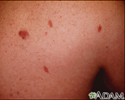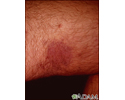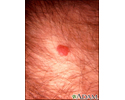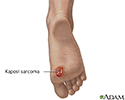Kaposi sarcoma
Kaposi's sarcoma; HIV - Kaposi; AIDS - Kaposi
Kaposi sarcoma is a cancerous tumor of the connective tissue, and is often associated with HIV/AIDS .
Tumor
A tumor is an abnormal growth of body tissue. Tumors can be cancerous (malignant) or noncancerous (benign).
HIV/AIDS
Human immunodeficiency virus (HIV) is the virus that causes AIDS. When a person becomes infected with HIV, the virus attacks and weakens the immune ...

Causes
Before the HIV/AIDS epidemic, Kaposi sarcoma was seen mainly in older Italian and Jewish men, and rarely, in older women. Among this group, the tumors developed slowly. In people with HIV/AIDS, the cancer can develop quickly. It may also involve the:
- Gastrointestinal tract
- Lungs
- Skin
- Other organs
In people with HIV/AIDS, Kaposi sarcoma is caused by an interaction between the human immunodeficiency virus (HIV), a weakened immune system, and the human herpesvirus-8 (HHV-8). Kaposi sarcoma has been linked to the spread of HIV/AIDS and HHV-8 through sexual activity.
People who have kidney or other organ transplants are also at risk for Kaposi sarcoma.
African Kaposi sarcoma is fairly common in young adult males living near the equator. One form is also common in young African children.
Symptoms
The tumors (lesions) most often appear as bluish-red or purple bumps on the skin. They are reddish-purple because they are rich in blood vessels.
The lesions may first appear on any part of the body. They also can appear inside the body. Lesions inside the body may bleed. Lesions in the lungs can cause bloody sputum or shortness of breath .
Bloody sputum
Coughing up blood is the spitting up of blood or bloody mucus from the lungs and throat (respiratory tract). Hemoptysis is the medical term for cough...
Shortness of breath
Breathing difficulty may involve:Difficult breathingUncomfortable breathingFeeling like you are not getting enough air

Exams and Tests
The health care provider will perform a physical exam, focusing on the lesions.
The following tests may be performed to diagnose Kaposi sarcoma:
-
Bronchoscopy
Bronchoscopy
Bronchoscopy is a test to view the airways and diagnose lung disease. It may also be used during the treatment of some lung conditions.
 ImageRead Article Now Book Mark Article
ImageRead Article Now Book Mark Article -
CT scan
CT scan
A computed tomography (CT) scan is an imaging method that uses x-rays to create pictures of cross-sections of the body. Related tests include:Abdomin...
 ImageRead Article Now Book Mark Article
ImageRead Article Now Book Mark Article -
Endoscopy
Endoscopy
Endoscopy is a way of looking inside the body using a flexible tube that has a small camera and light on the end of it. This instrument is called an...
 ImageRead Article Now Book Mark Article
ImageRead Article Now Book Mark Article -
Skin biopsy
Skin biopsy
A skin lesion biopsy is when a small amount of skin is removed so it can be examined. The skin is tested to look for skin conditions or diseases. A...
 ImageRead Article Now Book Mark Article
ImageRead Article Now Book Mark Article
Treatment
How this condition is treated depends on:
-
How much the immune system is suppressed (
immunosuppression
)
Immunosuppression
Immunodeficiency disorders occur when the body's immune response is reduced or absent.
 ImageRead Article Now Book Mark Article
ImageRead Article Now Book Mark Article - Number and location of the tumors
- Symptoms
Treatments include:
- Antiviral therapy against HIV, since there is no specific therapy for HHV-8
-
Combination
chemotherapy
Chemotherapy
The term chemotherapy is used to describe cancer-killing drugs. Chemotherapy may be used to:Cure the cancerShrink the cancerPrevent the cancer from ...
 ImageRead Article Now Book Mark Article
ImageRead Article Now Book Mark Article - Freezing the lesions
-
Radiation therapy
Radiation therapy
Radiation therapy uses high-powered x-rays, particles, or radioactive seeds to kill cancer cells.
 ImageRead Article Now Book Mark Article
ImageRead Article Now Book Mark Article
Lesions may return after treatment.
Outlook (Prognosis)
Treating Kaposi sarcoma does not improve the chances of survival from HIV/AIDS itself. The outlook depends on the person's immune status and how much of the HIV virus is in their blood (viral load). If the HIV is controlled with medicine the lesions will often shrink away on their own.
Possible Complications
Complications can include:
- Cough (possibly bloody) and shortness of breath if the disease is in the lungs
- Leg swelling that may be painful or cause infections if the disease is in the lymph nodes of the legs
The tumors can return even after treatment. Kaposi sarcoma can be deadly for a person with AIDS.
An aggressive form of African Kaposi sarcoma can spread quickly to the bones. Another form found in African children does not affect the skin. Instead, it spreads through the lymph nodes and vital organs, and can quickly become deadly.
Prevention
Safer sexual practices can prevent HIV infection. This prevents HIV/AIDS and its complications, including Kaposi sarcoma.
Kaposi sarcoma almost never occurs in people with HIV/AIDS whose disease is well-controlled.
References
Kaye KM. Kaposi's sarcoma-associated herpesvirus (human herpesvirus 8). In: Bennett JE, Dolin R, Blaser MJ, eds. Mandell, Douglas, and Bennett's Principles and Practice of Infectious Diseases, Updated Edition . 8th ed. Philadelphia, PA: Elsevier Saunders; 2015:chap 143.
Lambert PF, Sugden B. Viruses and human cancer. In: Niederhuber JE, Armitage JO, Doroshow JH, Kastan MB, Tepper JE, eds. Abeloff's Clinical Oncology . 5th ed. Philadelphia, PA: Elsevier Churchill Livingstone; 2014:chap 11.
-
Kaposi's sarcoma - lesion on the foot - illustration
Kaposi's sarcoma on the foot. This once-rare malignancy of the blood vessels is now associated with AIDS. It is more frequently associated with AIDS in homosexual men than AIDS in IV drug users. The malignancy results in purplish grape-like lesions in the skin, gastrointestinal tract and other organs.
Kaposi's sarcoma - lesion on the foot
illustration
-
Kaposi's sarcoma on the back - illustration
Kaposi's sarcoma was once a rare malignancy of the blood vessels but is now associated with AIDS. It is more frequently associated with AIDS in homosexual men than AIDS in IV drug users. Recent research has suggested that this malignancy may be caused by a newly discovered herpes virus. The malignancy results in purplish, grape-like lesions in the skin, gastrointestinal tract, and other organs.
Kaposi's sarcoma on the back
illustration
-
Kaposi's sarcoma - close-up - illustration
Kaposi's sarcoma was once a rare malignancy of the blood vessels but is now associated with AIDS. It is more frequently associated with AIDS in homosexual men than AIDS in IV drug users. The malignancy results most frequently in purplish to reddish-purple flat or grape-like lesions in the skin, gastrointestinal tract, and other organs.
Kaposi's sarcoma - close-up
illustration
-
Kaposi's sarcoma on the thigh - illustration
Kaposi's sarcoma, seen here on the thigh, was once a rare malignancy of the blood vessels, but is now associated with AIDS. It is more frequently associated with AIDS in homosexual men than AIDS in IV drug users. The malignancy results in purplish to reddish-purple grape-like lesions in the skin, gastrointestinal tract, and other organs.
Kaposi's sarcoma on the thigh
illustration
-
Kaposi's sarcoma - perianal - illustration
Kaposi's sarcoma usually occurs in male homosexuals with AIDS. These lesions can appear anywhere on the body as purple, elevated growths. This sarcoma is located near the anus (perianal).
Kaposi's sarcoma - perianal
illustration
-
Kaposi's sarcoma on foot - illustration
Kaposi sarcoma is a malignant tumor of the connective tissue.
Kaposi's sarcoma on foot
illustration
-
Kaposi's sarcoma - lesion on the foot - illustration
Kaposi's sarcoma on the foot. This once-rare malignancy of the blood vessels is now associated with AIDS. It is more frequently associated with AIDS in homosexual men than AIDS in IV drug users. The malignancy results in purplish grape-like lesions in the skin, gastrointestinal tract and other organs.
Kaposi's sarcoma - lesion on the foot
illustration
-
Kaposi's sarcoma on the back - illustration
Kaposi's sarcoma was once a rare malignancy of the blood vessels but is now associated with AIDS. It is more frequently associated with AIDS in homosexual men than AIDS in IV drug users. Recent research has suggested that this malignancy may be caused by a newly discovered herpes virus. The malignancy results in purplish, grape-like lesions in the skin, gastrointestinal tract, and other organs.
Kaposi's sarcoma on the back
illustration
-
Kaposi's sarcoma - close-up - illustration
Kaposi's sarcoma was once a rare malignancy of the blood vessels but is now associated with AIDS. It is more frequently associated with AIDS in homosexual men than AIDS in IV drug users. The malignancy results most frequently in purplish to reddish-purple flat or grape-like lesions in the skin, gastrointestinal tract, and other organs.
Kaposi's sarcoma - close-up
illustration
-
Kaposi's sarcoma on the thigh - illustration
Kaposi's sarcoma, seen here on the thigh, was once a rare malignancy of the blood vessels, but is now associated with AIDS. It is more frequently associated with AIDS in homosexual men than AIDS in IV drug users. The malignancy results in purplish to reddish-purple grape-like lesions in the skin, gastrointestinal tract, and other organs.
Kaposi's sarcoma on the thigh
illustration
-
Kaposi's sarcoma - perianal - illustration
Kaposi's sarcoma usually occurs in male homosexuals with AIDS. These lesions can appear anywhere on the body as purple, elevated growths. This sarcoma is located near the anus (perianal).
Kaposi's sarcoma - perianal
illustration
-
Kaposi's sarcoma on foot - illustration
Kaposi sarcoma is a malignant tumor of the connective tissue.
Kaposi's sarcoma on foot
illustration
Review Date: 11/27/2016
Reviewed By: Arnold Lentnek, MD, Infectious Diseases Medical Practice of NY and Clinical Research Centers of CT. Review provided by VeriMed Healthcare Network. Also reviewed by David Zieve, MD, MHA, Medical Director, Brenda Conaway, Editorial Director, and the A.D.A.M. Editorial team.






